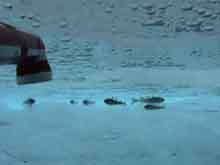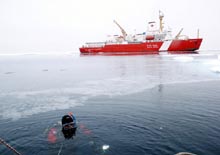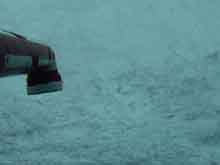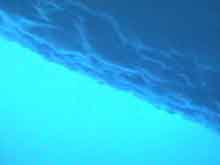
Group of Arctic cod, Boreogadus saida, resting in an ice gap. The fish show no signs of escaping behavior. (Photo courtesy of Rolf Gradinger.) Click image for larger view.
Life in cold gaps
September 3, 2002
Rolf Gradinger and Bodil Bluhm
University of Alaska Fairbanks
![]() Explore the gaps in between layers of ice floes, where arctic cod and other organisms rest, to avoid predation. (mp4, 3.1 MB)
Explore the gaps in between layers of ice floes, where arctic cod and other organisms rest, to avoid predation. (mp4, 3.1 MB)
Only five days left until our cruise ends in Barrow, Alaska. Today, CTDs and a JAMSTEC mooring dominated the ship’s activities. We are in “open water”, meaning there is no sea ice present. Consequently, we had no opportunities to learn more about the sea ice ecosystem and its relation to other Arctic realms.
All in all, we were allowed to work on the ice four times during the entire cruise. While it will enable us to start an inventory of sea ice organisms for the off shore area of the Beaufort Sea, the sample size is too small to distinguish differences within our region of interest. So far, we documented the occurrence of several small metazoan species in the ice. We found animals in the bottom 15cm of the ice floes in abundances of 5 to 20 organisms per liter of melted sea ice. At our last ice coring station on August 27, we could see red turbellarians immediately after we took our ice cores. Although they are rather small, with a length of about 1 mm, we could see them crawling in the bottom layers of the sea ice because of their bright red color.
The narrow passages between the ice crystals facilitate the life of small creatures (<1mm) within the ice. Fish and larger amphipods, on the other hand, were detected at the ice-ocean interface by our dive team. Video transects with divers were conducted at seven stations. They recorded about 2 hours of digital video documenting the topography of the underside of the sea ice and the life in this region, which has hardly been studied in this much detail in the Beaufort Sea.
The video recordings reveal a large variability in the under-ice morphology from station to station. Most interesting to us was the visible occurrence of melt-water layers of a few cm thickness both in the leads between and in depressions below the ice floes--so-called under-ice melt ponds. The low salinity melt-water is run off from the ice and accumulates at the top of the water column due to its low density. When the divers crossed the boundaries between the fresher melt-water and the underlying seawater, their turbulence created mixing zones that were milky in appearance. These fresh water layers are extremely meaningful for ice related life as the reduced salinity impacts the physiology of the organisms as well as the supply of nutrients from the water below. Our recordings also showed a profound change in the ice morphology. The cold seawater initiated freezing in the under-ice melt ponds. Large ice crystals of several cm length form through this process and fill up any irregularities at the underside of the ice, until the bottom of the ice appears flat and smooth (below, left image). At stations without significant freshwater accumulations, the under-ice topography was very different and dominated by a mosaic of depressions and protrusions (below, right image) on the scale of decimeters.

Our fish and amphipod trap deployed below the sea ice. (Photo courtesy of Rolf Gradinger.) Click image for larger view.

Department of Fisheries and Oceans Canada ice-diver, Wayne Smith, floats at the surface of the icy Arctic water in preparation for the first science dive of the day. Click image for larger view.
In our search for life within and associated with the Arctic sea ice, Arctic cod was one of our target species. Arctic cod (Boreogadus saida) is a true polar species occurring all over the Arctic. Its biology is relatively well studied in coastal locations with seasonal ice cover, e.g., in Alaskan waters. After ice melt in late spring, huge aggregations of juvenile Arctic cod enter the shallow coastal lagoons to feed on benthic crustaceans. Although we know that Arctic cod also occur in the central Arctic Ocean, we have only sporadic insights into its biology. Several critical types of habitat that are utilized in coastal waters, like those shallow lagoons, are missing in the high Arctic. Our scarce knowledge on offshore arctic cod is based on a few rare catches and analyses of the stomach contents and their biochemical composition. We had hoped to learn more about Arctic cod, specifically about habitat preferences the species has in offshore waters covered with ice year round. The first dives were very disappointing in that respect, since we did not see a single fish. The under-ice ROV dive brought spectacular images of the icy landscape, but fish were not detected. However, the dives on Aug 24 were a major breakthrough. After finishing our routine video transect, Paul, the photographer from the National Geographic Society who was shooting under water that day, reported a sighting of some cod in the ice. Although the water was cold and the divers were exhausted, we convinced them to dive again and try to document this sighting on video. The footage we received was amazing. Arctic cod were hiding in little gaps just below the top layers of the ice floes. Summer melt produces narrow horizontal gaps in the ice, which can reach several meters into the ice floe from its edge and measure only 5 to 15 cm in thickness at the end of the gap. These gaps seem to be Arctic cod habitat. On all following stations, we checked for cod, and we were 100% successful. We assume that juvenile Arctic cod use these gaps as a place for rest and hiding in the summer. The fish we saw were very inactive and not impressed by divers at all. Even when Paul, Jeremy and Wayne (other divers) approached them to get good shots or recordings, the fish did not hide or try to escape. Sit and wait seems to be a good strategy to survive in the Arctic.
Any kind of activity has its metabolic costs, and doing nothing saves a lot of energy. Such strategies are already well documented for many polar life forms on land and in the ocean. At this point, however, we do not know whether the ice-associated cod is a sit-and-wait predator with certain hours of activity during every day. Unfortunately, we could not catch any specimens for analysis of their feeding preferences, although we deployed a fish trap twice. Our native guides, Joe and John, gave us some very valuable recommendations on how to be more successful in the future.
Interestingly, no polar cod was ever seen solo. Group sizes varied from two to over 15 animals per gap. Schooling of fish is mostly interpreted as a behavioral adaptation to avoid predators or socially feed, but in this case, it could be indicative of scarce availability of critical habitat (gaps). Based on our observations, I assume that two factors are crucial to the survival of Arctic cod in the central Arctic, and both are provided by the sea ice, food and habitat. Without ice, there would be no gaps for resting and hiding from birds and seals, and ice amphipods would not be present. We do not know how successful Arctic cod would be in catching the fast moving pelagic crustaceans, and whether they can switch to copepods or other zooplankton at times of no ice. Our findings strongly support the hypothesis that the predicted loss of multiyear ice cover in the Arctic will reduce the success of this species in the marine theatre of natural competition.
Sign up for the Ocean Explorer E-mail Update List.




























